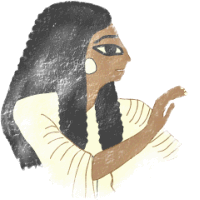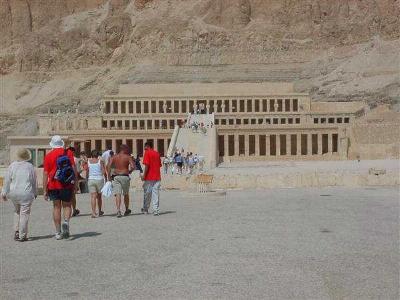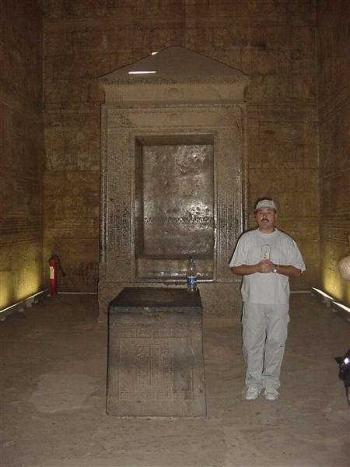An Egyptian Tale: Part II
Created | Updated Nov 11, 2002

Munchkin and Toccata sail down the Nile, keeping an eye out for any Belgian detectives.
Day 3
Up very early, 5.30 am in fact for breakfast which was somewhat annoyingly accompanied by Brahms's Lullaby over the tannoy system. Luckily I managed to stay awake long enough to actually get through breakfast and then off to Valley of the Kings. Astounding, terrible, stark, blazing, grand. All words I would use to describe the valley. It sits on the west bank of the Nile and is within spitting distance of the irrigated section. However it is most definitely in the Sahara desert. This is one of the things that really amazed me about Egypt. I didn't realise until I was there quite how narrow the cultivated area in Egypt is and how abruptly it stops. It is only one or two miles wide and you could have a field of sugar cane, a row of palm trees as a hedge and them a few feet of rapidly thinning grass before the desert takes hold. And then nothing grows at all.
While in the Valley of the Kings, a steep-sided little valley in the desert hills, we visited 3 tombs; Rameses IV and VII and Tutmosis III. The first two were simple but beautiful tombs. They had a straight corridor down to the sarcophagus covered in stunning scenes from the 'Book of The Dead' and the occasional piece of graffiti. Then an open area for the burial chamber and the occasional little side chamber. Interestingly, the longer the Pharaoh lived the more little side chambers there were. This is simply because it wasn't deemed to be very nice to turn round to your king and say; 'Aw'right Guv, yer tomb's finished, so when ever yer want to get in like'.

Tutmosis III(1479-1425 BC)'s tomb was, however, something special. Being one of the first to use the site he was especially obsessed with being hidden from tomb robbers. Hence to get to his tomb you need to climb a metal staircase for a hundred steps, travel through a ravine barely wide enough for one and then down another hundred steps into the rock. Then through a special trap room with deep floor and into the ante chamber. Down some more stairs took you to the actual, cartouche shaped, tomb. The art here was much more simple, indeed Toccata took some convincing that it hadn't been done in biro, but as it was the first tomb to be decorated this is to be expected. Sadly the ventilation in this tomb was a bit duff, no idea of how to accommodate tourists these Ancient Egyptians, so we couldn't stay very long.
Then on to an alabaster factory for the hard sell which I really did not want. The hills around Thebes/Luxor are full of alabaster and there are hundreds of little workshops apparently shaping it by hand in the area. We were taken to one, given a brief show of traditional methods of alabaster working and then followed around until we agreed to buy something, and pay the man who wrapped it some baksheesh. This annoyed me somewhat as, while the stuff was nice, I wasn't that interested yet I was beavered away at all the time we were there. Toccata was hassled for baksheesh after she bought something, but we had no change which made things very awkward, as he just would not go away.
We finally got away with only a few evil looks and the tour carried on to the funerary temple of Queen Hatshepsut. Amazing and huge in the blazing sun but unfortunately vandalised by her stepson/husband/successor. Queen Hatshepsut was the wife of Tutmosis II who became regent when he died as his son, Tutmosis III, was too young. She first married her stepson and then had him locked up and declared herself Pharaoh, even going so far as to show herself as a man on her statues. However, when she died Tutmosis III came to power and had many of her monuments defaced. Others through the years - such as early Christians who used the place as a monastery - have further defaced her temple so that now, while it looks very impressive from a distance, there is little to see close up.
After a very long morning we headed back to the boat for lunch and a greatly needed siesta before going back out into the heat of Karnak.
Karnak is the largest religious area in the ancient world. This is quite a dry fact and gives you no indication as to how absolutely huge it is. The famous hypostyle (pillared) hall as seen in Death On The Nile is 6000 square metres in area, apparently large enough to get both St Peters in Rome and St Paul's in London into. It is impossible to get a full idea while standing in it and all you can do is spin round, staring up at the tops of pillars and gawp. Nineteenth century writer Amelia Edwards wrote; 'It is a place that has been much written about and often painted; but of which no writing and no art can convey more than a dwarfed and pallid impression... The scale is too vast; the effect too tremendous; the sense of one's own dumbness, and littleness, and incapacity, too complete and crushing.' I agree entirely. While there we saw statues of Rameses II (The Great), temples by Nubian pharaohs, obelisks by Queen Hatshepsut subsequently overbuilt by her son, a huge natural spring lake and more side temples, richly decorated hypostyle halls and sanctuaries than you can shake a jackal headed god at. I could have stayed there for days but sadly we had to move on to yet another temple.
Luxor Temple was begun by Hatshepsut and then expanded by Rameses II, Greeks, Romans, Coptic Christians and even the Muslims who built a mosque on the buried ruins in the 13th Century. The front of the temple originally had two statues of Rameses II and two obelisks. However, when a Frenchman deciphered hieroglyphics, the Egyptian government gave France one of the obelisks and it now stands in the Place de Concorde in Paris. Passing these statues the temple follows the standard pattern, two great guard towers or pylons, an open courtyard for the worshipers to congregate in, a hypostyle hall and then the sanctuary. The Sanctuary of this temple was used by early Christians and even has some paintings of the Last Supper on the Walls, covering the hieroglyphs. By the end of this day I was starting to get temple fatigue but tomorrow was to be a short day.
Day 4 - Toccata's birthday

Also an overnight cruise to Edfu, arriving at eleven. This allowed a slow morning up on deck before a horse and cart ride to the Temple of Horus, the falcon god and husband of Hathor of Dendera. This cart ride was another cunning attempt to part us from our money as it took us to one end of a small bazaar, with the temple at the other. Also, as we had all turned up in batches of four we had to wait for the rest of the group, meaning that those at the front were besieged by stallholders desperate for us to visit their shop on the way past. You can tell that this is a standard trick from the way the vultures descended and I can't say I was impressed with the tour company and our guide. Anyhoo, ten minutes of hassle, followed by the now standard walk past all the screaming sellers to the temple which, luckily, was worth it. Not that I ever found a temple that wasn't.
Edfu was a very well-preserved late Ptolemaic temple with oodles of visible stone work. Found in the temple during excavations were papyrus sheets detailing the temple doings, such as how much money the temple collected and distributed to the poor and also a sheet detailing the design of the temple. Interestingly this design document was signed by someone called Imhotep, which is the name of the guy who designed the first pyramid at Saqarra. So, either this was a previously unknown other architect with the same name, the original Imhotep's plans, having survived a couple of thousand years before the temple was even built, or some pre-Christian forgery.
Also found when the temple was dug out of the sand was the ceremonial barge used for moving the statue of the god during the annual renewal ceremony. At one point each year the statue of the god would be removed from the sanctuary and placed on the barge. It would then be carried out into the courtyard to be seen by the worshippers and to receive the rays of the sun, to 'recharge' its power. The original has been removed to Cairo but a replica has been put in its place to be flash-photographed for all it is worth. Also wonderfully preserved is the sanctuary which includes carvings of Alexander the Great, dressed as a Pharaoh, paying homage to the Egyptian gods.
Back to the boat for lunch and the cruise to Aswan. As we glide past, the east bank gets smaller and less green as hills and mountains march out of the desert but the west bank remains incredibly lush. Turning from one bank to the other is almost like looking at two different countries.
At dinner that evening the head waiter checks who Toccata is and, as we finish our coffee, a banging of drums and singing starts up from the kitchen. All the waiters then dance out from the kitchen, singing for all they are worth and encouraging us all along as they bring a cake to Toccata's side. I get the most evil look in Christendom, or possibly Islam Dom, but it is nothing to do with me. We all try a bit of the cake, delicious, before Toc beats a hasty retreat to a gin on the deck. Finally we head for our room where we find the counterpanes twisted up into a fine impression of sunglasses wearing swans. Its all getting a little too surreal for my heat-addled brain so I ignore it and go to bed...
